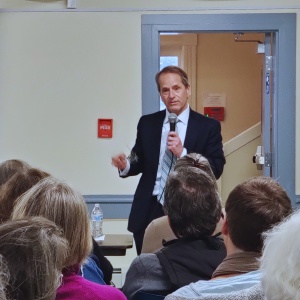Boston College senior studying Antrim wind turbine data
| Published: 02-28-2023 5:35 PM |
Megan Sharkey is a senior at Boston College, and for years, she has been studying the Antrim wind turbines. Now, she’s in the process of completing a thesis project on her research.
One of Sharkey’s professors, seismologist Alan Kafka, has a high school friend who lives in Antrim. He has a recording device on his property that can detect shakes of the Earth and infrasonic booms, which are low-frequency sound waves.
It is meant to pick up “any vibrations on Earth’s surface and atmosphere,” Sharkey explained. She has looking at data collected every day and searched for patterns, and since the wind turbines started running in 2019, she has picked up beat-like infrasound signals that doesn’t resemble the sound waves she’d expect.
Infrasound waves are below 20 hertz, in the range below the low limit of human hearing.
“It’s a distinct shape that isn’t natural,” she said. She doesn’t know for certain that they’re coming from the wind turbines, but she has been tracking and analyzing when they show up. She said they’re a bit sporadic, and “some days they don’t happen at all.”
“The source has to be energetically significant, move a large volume of air,” said Sharkey, so it is plausible that the wind turbines could produce them.
When Sharkey started researching wind energy, she learned that there has been a lot of pushback, especially in residential areas. People are worried about bird and bat deaths, noise, cost and the potential to decrease property values on nearby lots.
“Then I started looking into studies about ‘wind turbine syndrome,’” she said, referring to the name for alleged negative health effects connected to being near wind turbines, for which infrasound has been blamed.
Article continues after...
Yesterday's Most Read Articles
 Peterborough voters approve a $11.7 million bond to fund a new Fire and Rescue Station
Peterborough voters approve a $11.7 million bond to fund a new Fire and Rescue Station
 ConVal’s Kimberly Rizzo Saunders named Superintendent of the Year
ConVal’s Kimberly Rizzo Saunders named Superintendent of the Year
 Reality Check receives approval to move into Redeeming Grace Church
Reality Check receives approval to move into Redeeming Grace Church
 Frank Edelblut speaks at Dublin Education Advisory Committee forum
Frank Edelblut speaks at Dublin Education Advisory Committee forum
 New look at Gregg Lake
New look at Gregg Lake
“There’s not significant evidence that it is hurting human health,” but the anti-wind movement has latched onto the concept and Sharkey said, “The possibility can create human panic.”
While Sharkey said a lot of the studies on wind turbine syndrome don’t have solid scientific backing, it piqued her interest in the public policy side of wind farms, in particular where they are installed and how they affect the people living near them.
“My study does not aim to draw any firm conclusions surrounding ‘wind turbine syndrome,’ but rather hopes to gauge how the Antrim public views and is impacted by the local turbine facility,” Sharkey said.
She has prepared a survey and hopes to reach as many Antrim residents as she can to get their feedback on how they feel about the wind turbines, if they hear them and if they are disturbed by them.
Sharkey is interested in environmental justice issues, which often involve people who live near and are ex posed to fossil-fuel production.
“With wind energy on the rise and a push for renewable energy, I’m very interested in where they’re going to put wind farms,” she said. “Are they going to be placed in communities that don’t have the capacity to fight them?”
The nine wind turbines in Antrim started making power in 2019, and were controversial within the community. In 2022, eight citizens and New Hampshire Wind Watch filed a lawsuit against the state’s Site Evaluation Committee, arguing the committee unlawfully changed interpretation of the rules around noise limitations around the Antrim project.
With her research, Sharkey hopes to “gain a comprehensive understanding of wind energy through the lens of earth science, with the added element of local public opinion of the Antrim Wind Project,” including what factors contribute to how people feel about wind energy.
“I hope to learn more about the relationship between scientific communication and public perception,” she said.


